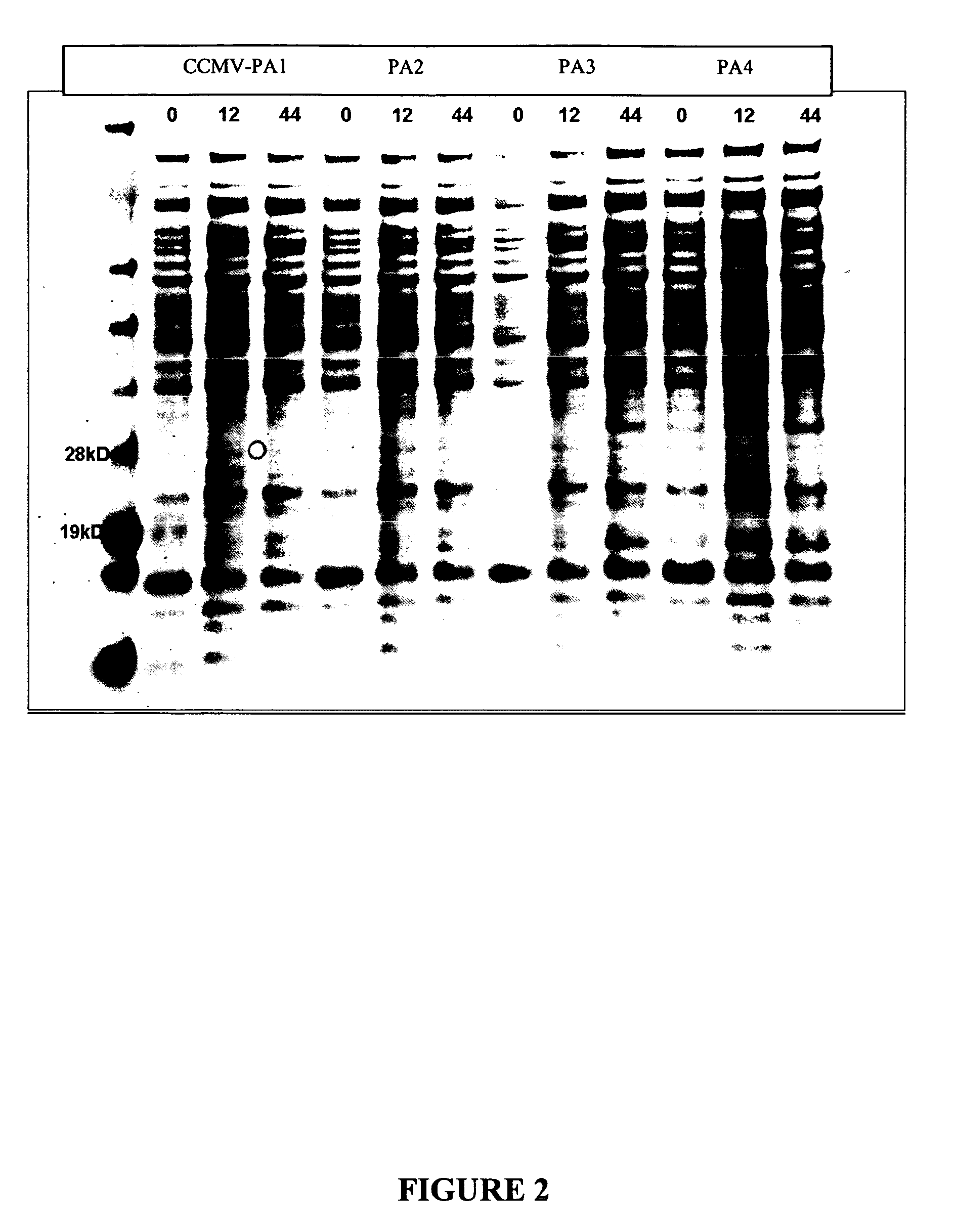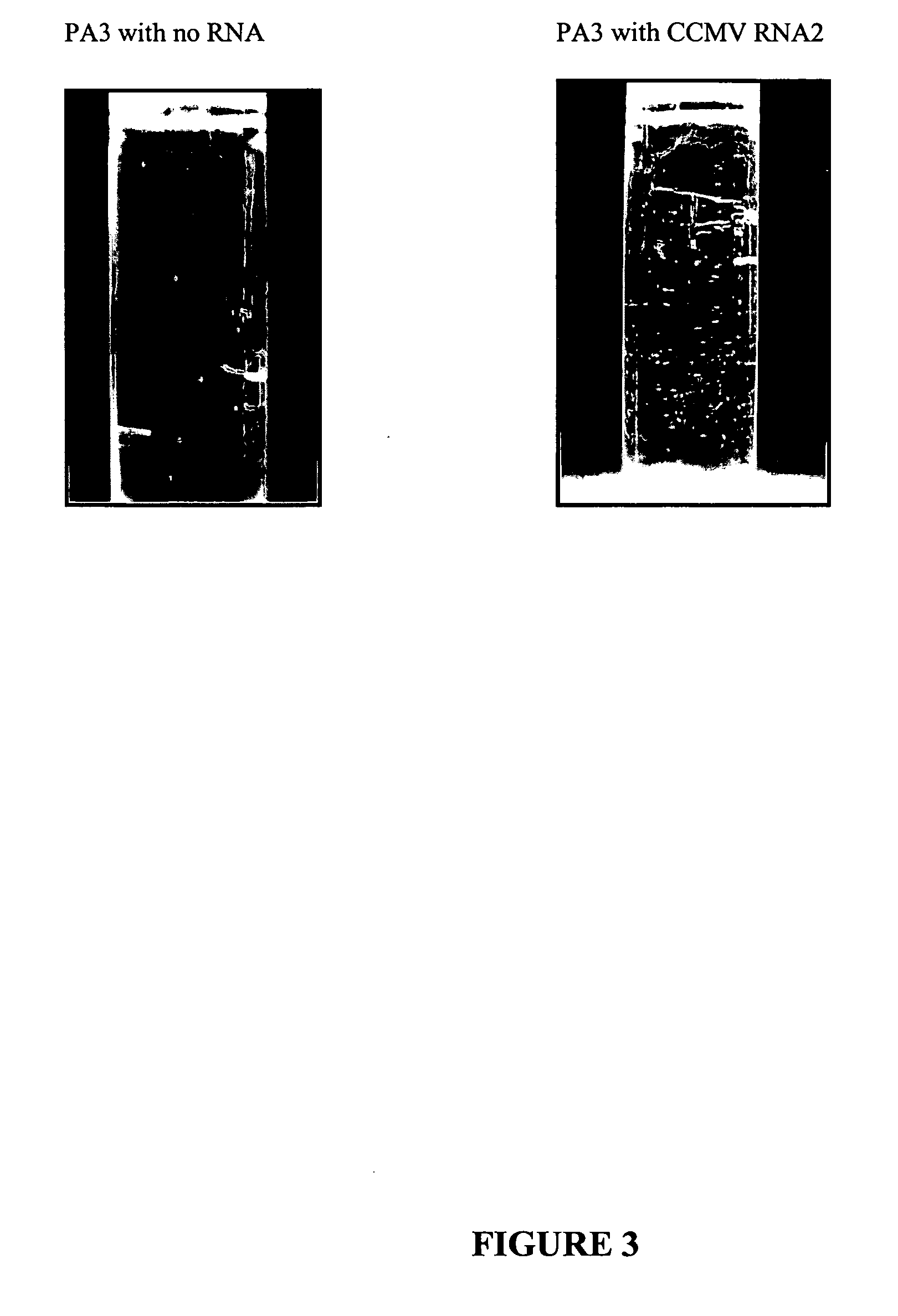Production of multivalent virus like particles
- Summary
- Abstract
- Description
- Claims
- Application Information
AI Technical Summary
Benefits of technology
Problems solved by technology
Method used
Image
Examples
example 1
Peptide Synthesis and Cloning into CCMV CP
[0120] 1.A. Protective Antigen Cloning
[0121] Four different Bacillus anthracis protective antigen (“PA”) peptides (PA1-PA4) were independently expressed in CCMV VLPs. Nucleic acids encoding PA1-PA4 were synthesized by SOE (splicing-by-overlap-extension) of synthetic oligonucleotides. Each of the inserts was synthesized by over-lapping DNA oligos with the thermocycling program detailed below:
PCR PROTOCOLReaction Mix (100 μL total volume)Thermocycling Steps10μl10× PT HIFI buffer *Step 11Cycle 2 min.94° C.4μL50 mM MgSO4 *Step 235Cycles30 sec.94° C.2μL10 mM dNTPs *Step 31Cycle30 sec.55° C.0.25ngEach PrimerStep 41Cycle 1 min.68° C.1-5ngTemplate DNA10 min.70° C.1μLPT HIFI Taq DNA Polymerase *Maintain 4° C.RemainderDistilled De-ionized H2O (ddH2O)
* (from Invitrogen Corp, Carlsbad, CA, USA, hereinafter “Invitrogen”)
[0122] The resulting nucleic acids contained BamHI recognition site termini. The nucleotide sequences encoding, and the amino acid ...
example 2
Expression of Recombinant CCMV Capsid Fusion Peptides
[0130] The CCMV129 fusion peptide expression plasmids were transformed into Pseudomonas fluorescens MB214 host cells according to the following protocol. Host cells were thawed gradually in vials maintained on ice. For each transformation, 1 μL purified expression plasmid DNA was added to the host cells and the resulting mixture was swirled gently with a pipette tip to mix, and then incubated on ice for 30 min. The mixture was transferred to electroporation disposable cuvettes (BioRad Gene Pulser Cuvette, 0.2 cm electrode gap, cat no. 165-2086). The cuvettes were placed into a Biorad Gene Pulser pre-set at 200 Ohms, 25 μfarads, 2.25 kV. Cells were pulse cells briefly (about 1-2 sec). Cold LB medium was then immediately added and the resulting suspension was incubated at 30° C. for 2 hours. Cells were then plated on LB tet15 (tetracycline-supplemented LB medium) agar and grown at 30° C. overnight.
[0131] One colony was picked from...
example 3
VLP Reassembly
[0135] 3.A. VLP Reassembly Without RNA:
[0136] To assemble the virus-like particles, 50 ml culture of Pseudomonas fluorescens host cells expressing recombinant capsid fusion peptides was French-pressed, and the soluble and insoluble fractions were separated by centrifugation. The insoluble inclusion bodies were washed two times. Samples from the soluble and insoluble fractions were taken and stored at −80° C. The insoluble fraction was resuspended in Buffer B (50 mM Tris pH 7.5, 1M NaCl, 1 mM DTT) containing 8 M urea at 4° C. overnight. The 8 M urea solution was then diluted in 0.25M increments with Buffer B down to a final concentration of 2.0 M urea. Polyethylenimine (PEI) was added to final concentration of 0.033%, and the solution was incubated on ice for 10 minutes. The supernatant was dialyze against Buffer B (3 changes of buffer) to completely remove urea overnight. The supernatant was centrifuged at 27,000×g for 30 minutes.
[0137] To determine the final yield ...
PUM
| Property | Measurement | Unit |
|---|---|---|
| Time | aaaaa | aaaaa |
| Temperature | aaaaa | aaaaa |
| Temperature | aaaaa | aaaaa |
Abstract
Description
Claims
Application Information
 Login to View More
Login to View More - R&D
- Intellectual Property
- Life Sciences
- Materials
- Tech Scout
- Unparalleled Data Quality
- Higher Quality Content
- 60% Fewer Hallucinations
Browse by: Latest US Patents, China's latest patents, Technical Efficacy Thesaurus, Application Domain, Technology Topic, Popular Technical Reports.
© 2025 PatSnap. All rights reserved.Legal|Privacy policy|Modern Slavery Act Transparency Statement|Sitemap|About US| Contact US: help@patsnap.com



